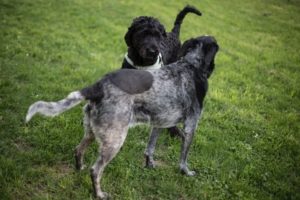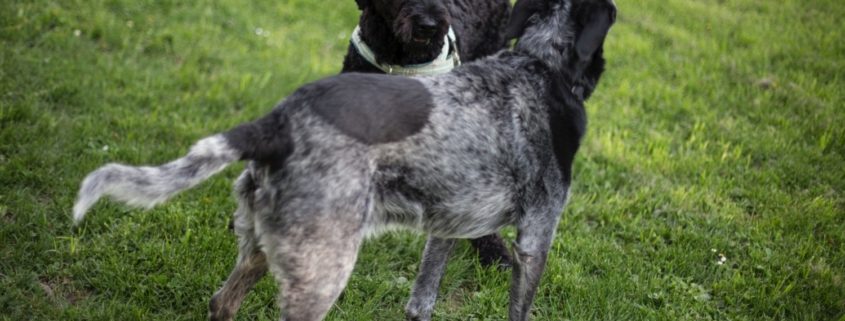Ask Crystal: New Years Dog to Dog Manners
Welcome to “Ask Crystal,” where you can ask your pet behavior questions! You can submit your question for Crystal at the bottom of the page!
Dear Crystal,
We will bring our almost-two-year-old pyr mix with us when we visit relatives over New Year’s. He loves everyone and is super friendly with other dogs. Our relatives have a dog that is high energy and “not always friendly” to other dogs, according to other family members. (Third hand info; we haven’t met this dog yet). What are some tips we can follow re: the dogs meeting each other? We have day care as a backup but want some tips to help make any possible interaction a positive one. Thanks!
Sincerely,
Friendly Fido
Dear Friendly,
I have found that many people don’t have a very good understanding of dog communication and body language. There are a lot of people who seem to think that every dog should allow every interaction with a good-natured grin. In fact, there are polite and rude interactions in dog greeting and play. They offer signals to start and stop interactions. These signals may start out subtle like turning their head away and escalate into growls or snaps depending on if the other dog responds appropriately. Some dogs jump to the more aggressive signals more quickly than others. Just like people have shorter fuses so do some dogs. Also, as dogs age, they tend to be less tolerant of puppyish rude behaviors. Corrections are a normal way that dogs tell each other what behavior is acceptable to them. It is entirely possible he was reacting to rude or annoying behavior from the other dog. I usually ask for any details the owners may have about the incidents and what happened. Details about the dogs such as age and play style may be helpful for determining what happened in previous incidents.
Without being able to see this dog’s prior interactions with other dogs, I can’t say whether he is going to be a dog that enjoys being around other dogs. If dogs don’t regularly interact with other dogs, they can become awkward and nervous with other dogs. I would suggest that you think about what exactly you want them to do. Is simply coexisting ok or are you wanting them to play? I would also suggest that even if it does go well that you have a place to put one of the dogs so that they don’t have to hang out together all the time. Dogs need breaks even if things are going well. Good stress is still stress and dogs can easily reach a point of over-stimulation.
 Ideally, you could do the introductions before New Year’s Eve so you don’t have to deal with that stress on the holiday. Also, understand that some dogs are stressed out by having guests in their house so that may make him a little bit grumpier that usual which may affect the introduction. My suggestion for introducing two dogs is taking a tandem walk outside. Dogs tend to do better outside because there is more open space. I would start by walking each dog on the outside of each person, so that the people are in the middle. If either dog is barking, growling or lunging, then you need to give them space by walking them further apart. Continue walking and slowly walk closer to each other as long as the dogs remain calm. The idea is to get the dogs to relax and walking usually helps dogs calm down. They can be in the presence of the other dog without being forced to interact. When both dogs are walking calmly, I would move the dogs closer so that the people are on the outside. I usually try to let one dog sniff the other’s rear when that dog is distracted sniffing something else. Face to face greetings are less than desirable but it can be hard to prevent it sometimes. When both dogs are calm and relaxed, allow them to quickly greet. I usually count to three and then separate them. The reason for this is that three seconds is usually not long enough for anything bad to happen. When the two dogs meet, we are looking for relaxed wiggly bodies. They may offer play bows or offer quick popping movements. If the dogs are very stiff or still, that may be a cause for concern. I would quickly call the dogs away and keep walking. When they seem relaxed, allow another greeting and see what the body language looks like. If that all looks loose and friendly, I would try some off leash play in a fenced area. I always let the dogs drag leashes around so I can safely grab them if things go south. You do not want to reach for a dog’s collar if they are fighting. That is one of the most common ways that people get bitten. If there is one dog I am more worried about, I may hold onto that dog’s leash and let the other dog loose. Another big tip is to be sure the people are walking around when the dogs are playing. If the dogs are tense and everyone is standing still the energy tends to stagnate and things can go south. If they are playing very intensely, I would encourage you to have them take breaks and not let them play for too long. Play can tip over into fights if it is too intense and goes on without breaks.
Ideally, you could do the introductions before New Year’s Eve so you don’t have to deal with that stress on the holiday. Also, understand that some dogs are stressed out by having guests in their house so that may make him a little bit grumpier that usual which may affect the introduction. My suggestion for introducing two dogs is taking a tandem walk outside. Dogs tend to do better outside because there is more open space. I would start by walking each dog on the outside of each person, so that the people are in the middle. If either dog is barking, growling or lunging, then you need to give them space by walking them further apart. Continue walking and slowly walk closer to each other as long as the dogs remain calm. The idea is to get the dogs to relax and walking usually helps dogs calm down. They can be in the presence of the other dog without being forced to interact. When both dogs are walking calmly, I would move the dogs closer so that the people are on the outside. I usually try to let one dog sniff the other’s rear when that dog is distracted sniffing something else. Face to face greetings are less than desirable but it can be hard to prevent it sometimes. When both dogs are calm and relaxed, allow them to quickly greet. I usually count to three and then separate them. The reason for this is that three seconds is usually not long enough for anything bad to happen. When the two dogs meet, we are looking for relaxed wiggly bodies. They may offer play bows or offer quick popping movements. If the dogs are very stiff or still, that may be a cause for concern. I would quickly call the dogs away and keep walking. When they seem relaxed, allow another greeting and see what the body language looks like. If that all looks loose and friendly, I would try some off leash play in a fenced area. I always let the dogs drag leashes around so I can safely grab them if things go south. You do not want to reach for a dog’s collar if they are fighting. That is one of the most common ways that people get bitten. If there is one dog I am more worried about, I may hold onto that dog’s leash and let the other dog loose. Another big tip is to be sure the people are walking around when the dogs are playing. If the dogs are tense and everyone is standing still the energy tends to stagnate and things can go south. If they are playing very intensely, I would encourage you to have them take breaks and not let them play for too long. Play can tip over into fights if it is too intense and goes on without breaks.
If the play seems tense and uncomfortable but the dogs seem ok just hanging out, you could keep them on leashes and just let them chill out around each other. Some dogs are fine coexisting but aren’t comfortable with play. I would hope that your dog could pick up on his body language and just leave him alone if that is the case. I would suggest that your relatives pick up any toys that their dog might feel possessive over. Don’t feed the two dogs food around each other. We don’t need to create any additional tension. Things tend to be a bit more tense inside the house so even if they seem comfortable outside, I would suggest leashes on inside at least initially. Confined spaces like hallways and doorways tend to be triggers for fights if there is tension between the two dogs, so be sure they aren’t walking in the door at the same time. When I am introducing two new dogs, I may attach one of the dog’s leashes to a heavy piece of furniture so they won’t crowd the other dog.
Some dogs appear grumpy initially but just need more time and space to get used to the other dog. Many times if they can see that the other dog respects their space, they can begin to relax. The important thing to always be watching is the dog’s body language and making sure that they look loose and wiggly. Stiff and still means you need to get them moving away from each other. I hope this helps you to have a safe and positive meeting between the two dogs. Happy New Years!
Until next time,
Crystal
Want more training for your animal? Sign up now for the first session of 2020 Manners 101 classes here!







